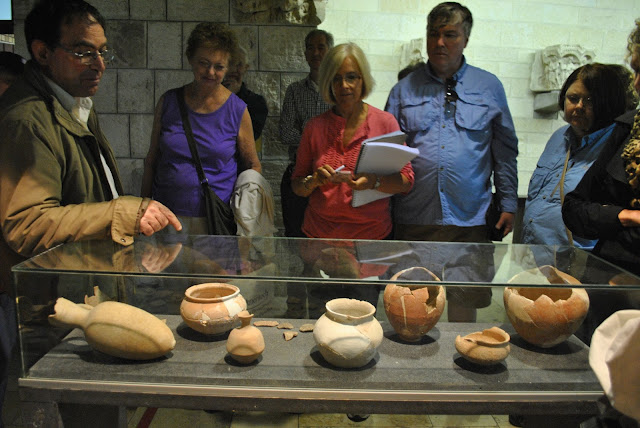After we left Megiddo, the bus took us to Nazareth.
In the Biblical times, it was a small, insignificant village. Today it is home to more than 80,000.
The bus let us off and we walked the rest of the way uphill to the Church of the Annunciation.
The church covers almost the entirety of the ancient town of Nazareth, whose population was in the hundreds, similar to Al's little hometown of Pretty Prairie, where everyone knows everybody.
Mary and Joseph were betrothed and living in Nazareth. It wasn't like the western idea of engagement. Evidently, girls were betrothed between the age of 3 and 11. Then they would marry at 12 1/2 or after. Fathers usually arranged a daughter's marriage as soon as possible. "Betrothal contracts were often made within the tribal families as such arrangements kept financial resources, customs, and physical security within the extended family unit." (much like my husband and I who are 3rd cousins!! And he is a 3rd cousin to himself too!)
The church was established at the site, where according to Roman Catholic tradition, the angel Gabriel, appeared to Mary to tell her that she would conceive the Saviour of the world.
But the angel said to her, “Do not be afraid, Mary; you have found favor with God. You will conceive and give birth to a son, and you are to call him Jesus. He will be great and will be called the Son of the Most High. The Lord God will give him the throne of his father David, and he will reign over Jacob’s descendants forever; his kingdom will never end.” Luke 1:30-33
The current church is a two-story building constructed in 1969 over the site of an earlier Byzantine-era and then Crusader-era church.

The lower level contains the Grotto of the Annunciation, believed by many Christians to be the remains of the original childhood home of Mary.
Inside the cave stands an altar with the Latin inscription “Here the Word was made flesh”.
All around the walls of the upper level chapel are mosaics from many countries. This is the one from Japan. In the picture above, the mosaic on the far right is the one from America. It is the only one without the Christ Child represented.
Ancient Nazareth, underneath the church. This home was from 1000 years before the time of Christ, but probably still in use when He lived there. Homes in the 1st century were built on top of bedrock into which caves (basements) were hewn. The cave would function for cooking or as a stable for several sheep and goats and for grain storage.

Who knows but that Mary might not have had a friend or relative in this home? Perhaps walked down these very steps?
Do you know the name of this cactus?
It is called "mother-in-law's seat"! I think I might resent that.
We got a tour through a museum at the site. It displays artifacts dating back to the 1st century. Here are 5 interestingly carved capitals, discovered buried in a cave in 1908. They were carved in France and crowned the columns at the entrance of the Crusader church.
Some of the pottery is from 2000 BC!
It was all so interesting!
Joseph's family origin was Bethlehem and the census of Caesar Augustus would have required anyone owning property to register in their home town. Mary and Joseph would leave Nazareth to go to Bethlehem, not only because Caesar said so, but to fulfill the prophesy regarding Jesus' birth. (Micah 5:2).
And one day, they would return to this village and Jesus would grow up here.
* * * * *
Leaving Nazareth....




























1 comment:
I am really enjoying all the pictures of your travels overseas! So neat to see it all! Thanks for sharing! Very exciting to see where Jesus lived/walked!!
Post a Comment